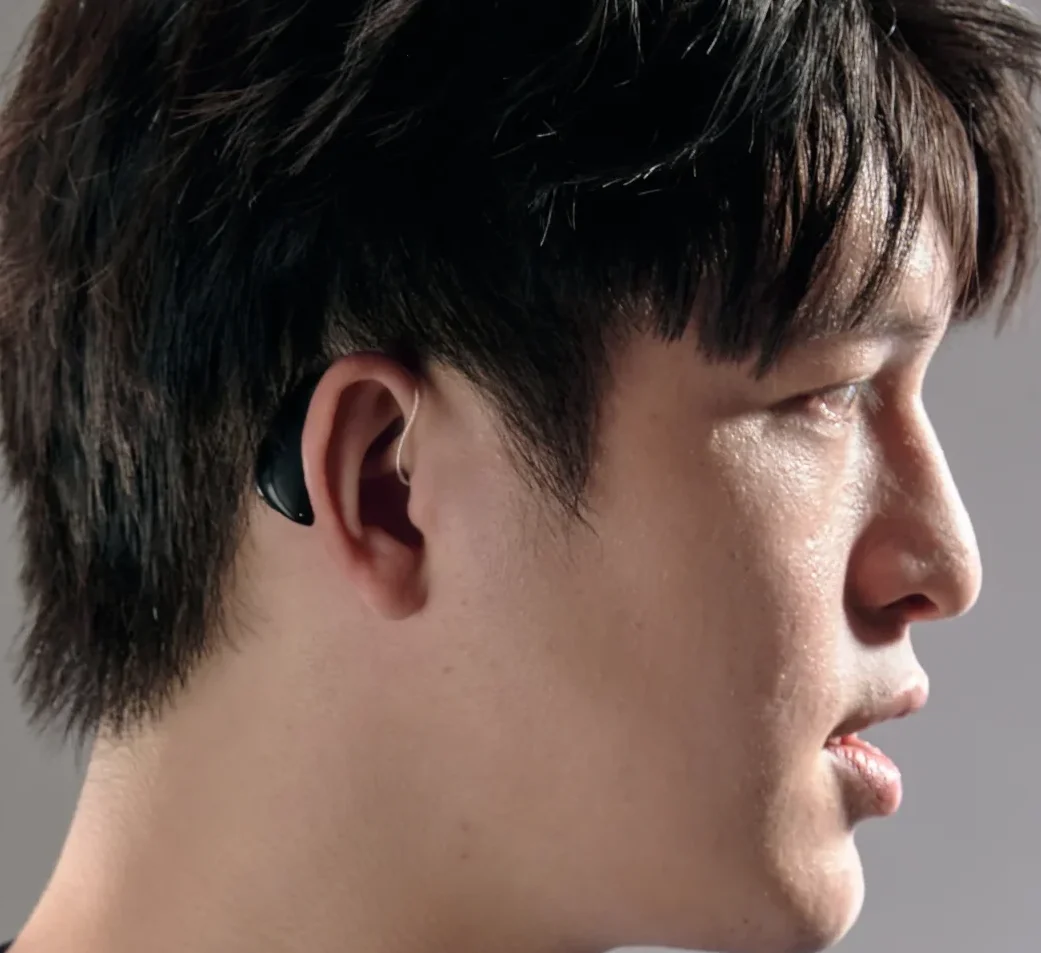
The Receiver-in-Canal (RIC) hearing aid closely resembles the Behind-the-Ear (BTE) hearing aid in appearance, with both featuring components that extend behind the ear and into the ear canal.
However, the key differentiating factor of a RIC hearing aid is the placement of the receiver (or speaker). As the name implies, a RIC hearing aid positions the speaker directly inside the ear canal.
This hearing aid style offers several notable advantages, including its tendency to be the first to adopt the latest technology. RIC hearing aids are also prized for their smaller and more streamlined design when compared to BTE alternatives.
It’s important to exercise care when handling this type of hearing aid, especially when removing it from the ear. This caution is warranted because the speaker wire runs behind the ear and connects to the eartip or earmold that is inserted into the ear canal. Any breakage or bending of the wire can result in damage to the speaker. Furthermore, the component inside the ear may require periodic replacement of wax guards, also known as wax traps, to prevent wax and debris from obstructing it.
Extensive Popularity
RIC (Receiver-In-Canal) hearing aids have gained widespread acclaim due to their sleek, discreet design, offering exceptional comfort that caters to various age groups and lifestyles, seamlessly integrating into daily routines.
Comfortable Design
Renowned for their ergonomic fit, RIC devices prioritize comfort by considering diverse ear shapes and sizes, reducing ear canal blockage and providing a more natural sound experience.
Versatile Fitting Range
Accommodating a broad spectrum of hearing needs, RIC aids offer customizable settings suitable for mild to severe cases, ensuring an optimal hearing experience tailored to individual requirements.
Natural Sound Enhancement
Discover the power of natural sound enhancement with our RIC (Receiver-in-Canal) hearing aids! Designed for both clarity and comfort, these advanced devices deliver crisp, clear sound while preserving the nuances of speech and surrounding sounds. With a discreet design, RIC hearing aids ensure you can wear them confidently in any setting. They adapt seamlessly to various environments, allowing you to engage fully in conversations and enjoy every moment.
Effective Feedback Reduction
Equipped with advanced feedback reduction mechanisms, RIC (Receiver-In-Canal) hearing aids minimize or eliminate whistling or feedback sounds, ensuring wearers experience uninterrupted and comfortable listening.
Pioneering Technology Integration
Often pioneering cutting-edge features, RIC aids lead the way in technological advancements, delivering improved speech recognition, enhanced connectivity, and advanced sound processing.
User-Friendly Volume Controls
RIC hearing aids come equipped with conveniently located volume buttons on the device’s body, allowing users easy access to adjust sound levels, ensuring a personalized and comfortable listening experience without the need for additional accessories or apps.
Bluetooth Connectivity
Offering seamless connectivity, these devices enable users to establish wireless connections with both iPhone and Android devices, facilitating direct streaming of phone calls, music, and other audio content, providing enhanced accessibility and convenience in everyday activities.
Telecoil Technology
Incorporating telecoil functionality, RIC hearing aids allow wearers to switch to telecoil mode in compatible environments, such as hearing loops in public spaces, ensuring clearer audio reception in venues equipped with this technology, enhancing overall hearing experiences.
Battery Options
RIC hearing aids are available in models offering either rechargeable or disposable battery options, providing users the flexibility to choose based on preferences and lifestyle. Rechargeable options offer convenience, while disposable battery models offer convenience for those without frequent access to charging facilities.
Remote Programming
Post initial fitting, RIC hearing aids often allow for remote programming, enabling wearers to make necessary adjustments or fine-tunings to their device settings without the need for additional in-person appointments, ensuring personalized and efficient ongoing care.
Over The Counter (OTC) Options
Some RIC hearing aids offer self-fit Over The Counter (OTC) alternatives, presenting cost-effective solutions for individuals seeking quality hearing assistance at lower prices. These options provide accessibility to effective hearing aids without extensive clinical visits, catering to diverse user needs and preferences.
| Aspect | Pros | Cons |
|---|---|---|
| Design | Smaller and less visible than BTE models | Microphone and processor may be more exposed. |
| Comfortness | Lighter and more comfortable to wear | May be less suitable for severe hearing loss. |
| Battery Life | Longer battery life compared to some styles. | Smaller size may use smaller, shorter-lasting batteries. |
| Directional microphones | Can have advanced directional microphones. | Some models may not have as advanced features. |
| Durability | Receiver is typically well-protected. | May be more susceptible to moisture exposure. |
